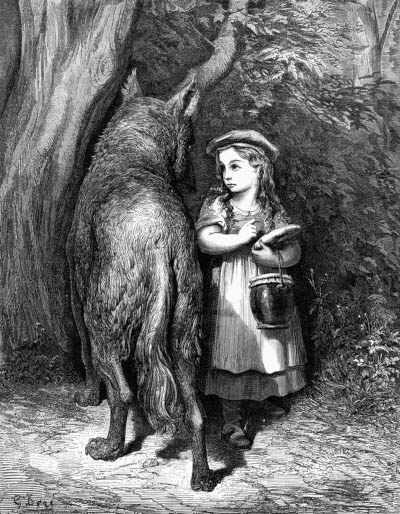Gustave Doré produced a number of illustrations for an edition of Charles Perrault's fairy tale classic, Les Contes de Perrault. It was published in 1862 and one of the best additions to it was titled Little Red Riding Hood.
The artist would cover this theme several times over, as both a painting and an illustration. In this composition we find Little Red Riding Hood meeting Old Father wolf in an outdoor setting. She is dressed in a pretty dress with a flat hat. She faces us and turns to look directly at the fox with a suspicious expression. The wolf has its back to us, displaying a long tail and a considerable height as it stands over the young girl. A tree leans over from the left hand side, helping to frame the main content. A flurry of leaves and other trees are then displayed across the rest of the background, giving us an environment of perhaps a forest. The artist lightens the foreground, helping us to identify more features of the two figures and it continues across the ground in the foreground which appears barren, other than for a few fallen leaves and branches. It is a beautifully constructed illustration with immense detail, even with a relatively simple composition. The artist then signed the piece in the bottom left corner, as was typical of his career.
Charles Perrault was a 17th century French author who is best known today for the likes of The Sleeping Beauty, Little Red Riding Hood, Cinderella, Puss in Boots and Bluebeard. All of these great titles were taken on by Doré himself. He would take old folk tales and re-invent them, creating the versions that today we are most familiar with. In order to lift these classic stories to another level, it was decided a good two centuries later that they could be combined with the finest illustrations in order to produce breaktaking, and highly memorable publications that could be cherished by adults and children together. This ambition brought about Les Contes de Perrault from 1862. The 1860s would prove to be a particularly important decade for the artist in which he released some of his most important book illustrations and would begin to scale up his output, hiring many assistants to help out with the printing process. He would later allow apprentices to complete some of his drawings too, whilst under his supervision. Whilst being a varied and ambitious artist who was curious about different mediums and content, it would be his book illustrations that achieved the most success.
Besides Little Red Riding Hood, the artist would produce around 10,000 drawings across his career and is considered by some to have been the finest book illustrator of all time. He would also take this particular topic into painting as well, where he was able to incorporate bright colour and a great use of tone variations which offered something different again to this well known topic. It was his illustrations that provided most of the funds that kept the artist profitable and also able to call upon the services of a team of assistants as his workload soared. He would bring in engravers who were able to turn his drawings into woodblocks which would then be used to print the designs into the books themselves. He wanted to focus on the earlier stages of development, where more creativity was involved. That said, there was still a considerable expertise required in the engraving process and sometimes the lead engravers would leave their own signature on the final artworks, to celebrate their own contributions within this labour-intensitve process which is rarely seen today within the printing industry.





